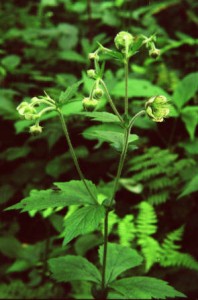“One man’s wilderness may be another’s roadside picnic ground.”1)
On a 200 acre plot of land near the North Carolina – Tennessee border, owners began bulldozing two roads. One road lead to the 6,198 ft. summit of Grassy Ridge Bald, while the second connected the property to NC highway 261.2) Conservationists took issue with a private land owner wanting to construct roads for easier accessibility. Starting in 1973, the Carolina Mountain Club noticed this development and protested the building of said roads. The CMC called for this 200 acre plot to enter into public domain, chiefly citing the area’s natural beauty and the obstruction commercialization would create. Not only does the lands surrounding Grassy Ridge have National Forest designation, but the road itself nearly intrudes on the Appalachian Trail. Because the Roan Highlands were in close proximity to other national forest land, preservation made sense to conservationists looking to expand the National Forest System. However, national conservation is in opposition to American ideas about private property.
To secure the land, the United States Government sued the Peake family who owned the tract. In order to reclaim 54 acres, the Department of Agriculture claimed this land to be condemned. The Peakes were a traditional mountain family and fought tooth and nail to prevent the U.S. Government from seizing their land. Realistically, the Peake family just wanted what was fair, as their land was now considered condemned, the Government could buy it back for less than its worth. In Kathryn Newfont’s book Blue Ridge Commons, she explores a history of successes and a history of setbacks in Western North Carolina conservation. While never explicitly mentioning the Roan Highlands, her work discusses the inherent struggle of environmental activism in the mountains. “The idea of wilderness failed to resonate with many longtime mountain residents.”3) Mountain people have a strong heritage rooted in independence. Newfont continues, the very notion of wilderness “seemed to them elitist, economically unsound, and historically dishonest.”4) Newfound marks the 1911 Weeks Act as the moment when environmental activism shifts. After this legislation the United States Government could purchase forestlands. Environmental activism was now filtered through the a strict national system complete with formal governance and bureaucracy.5)
Without government involvement, these endangered species living in the Peake tract of the Roan Highlands might have lost all their livable habitat. However, only looking at end results, was serious government time and money worth the preservation of these three species:
- Carolina Northern Flying Squirrel (Glaucomys sabrinus coloratus)
- Gray’s Lily (Lilium grayi)
- Bent Avens (Geum geniculatum)
References
| ↑1 | Nash, Roderick Frazier, Wilderness and the American Mind. 4th. ed. New Have, CT: Yale University Press, 1982. |
|---|---|
| ↑2 | “Preservation of Roan Highlands,” Carolina Mountain Club Papers, Box 16, Folder 10, University of North Carolina Asheville Ramsey Library, Asheville, NC. 1973 |
| ↑3, ↑4, ↑5 | Newfont, Kathryn, Blue Ridge Commons: Environmental Activism and Forest History in Western North Carolina. Athens, GA: University of Georgia Press, 2012. |



